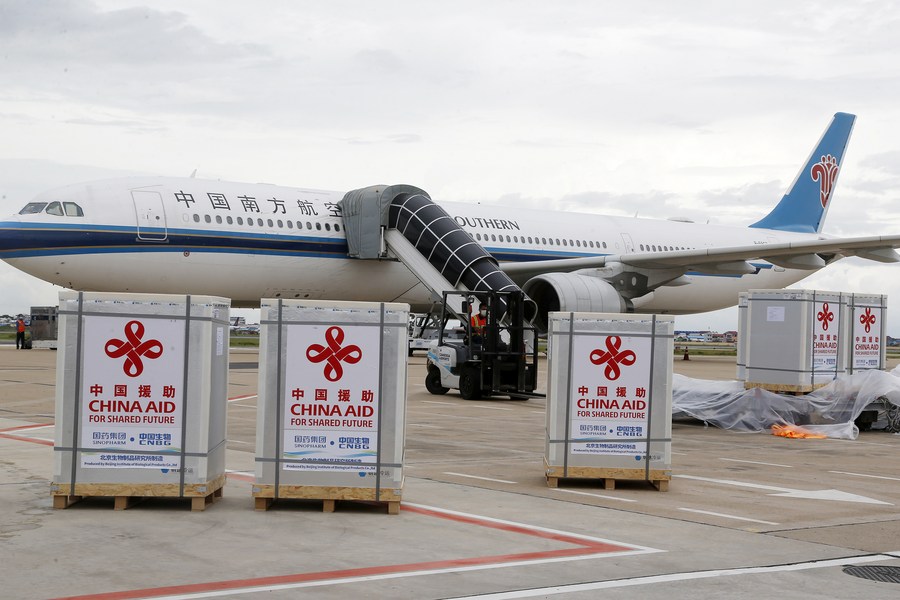BRI partners pledge closer cooperation for pandemic response, economic recovery

Photo taken on June 8, 2021 shows packages of Chinese COVID-19 vaccines arriving at the Phnom Penh International Airport in Phnom Penh, Cambodia. (Photo by Phearum/Xinhua)
--China has been engaged in extensive vaccine cooperation with many countries, and has donated and exported more than 400 million doses of finished and bulk vaccines to more than 90 countries, most of which are BRI partners.
--Following China's footsteps in pandemic response, more countries are demonstrating the will to forge unity through shared political commitments and shared responsibility to tackle the global health crisis of COVID-19.
--The green development initiative has accommodated the need for environmental conservation and development, a pragmatic and timely move to contribute to global recovery and the United Nations 2030 Agenda for Sustainable Development.
BEIJING, June 24 (Xinhua) -- Countries in the Asia-Pacific region have pledged to enhance cooperation on COVID-19 vaccines and green development under the Belt and Road Initiative (BRI) by forging a closer partnership.
The move came as relevant initiatives were launched by 29 countries, including China, Colombia, Indonesia and Pakistan, at the Asia and Pacific High-level Conference on Belt and Road Cooperation held Wednesday via video link.
The conference was held to forge new consensus among countries in the Asia-Pacific region on jointly fighting the pandemic and promoting sustainable economic recovery, according to the Chinese foreign ministry.
STRENGTHENING VACCINE COOPERATION
As of Wednesday, more than 178 million confirmed cases of COVID-19 have been reported globally with over 3.88 million deaths, while the coronavirus variants continue to pose threats.
Concerning cooperation on coronavirus vaccines, a powerful weapon for defeating the pandemic, the Asia-Pacific countries have called for providing more vaccines to the World Health Organization's COVAX initiative, supporting governments and enterprises to donate or export vaccines at an affordable price to developing countries, as well as transferring relevant technologies, as put forth in the Initiative for Belt and Road Partnership on COVID-19 Vaccines Cooperation.

Photo taken on June 1, 2021 shows vials of Sinopharm vaccines in Beijing, capital of China. The first batch of Chinese vaccines supplied to COVAX on June 1 officially rolled off the production line. (Xinhua)
"Dealing with the havoc in the region and the world caused by COVID-19 is not the responsibility of any single country," Kin Phea, director-general of the International Relations Institute of Cambodia, told Xinhua, adding that the initiative's focus on developing countries is to address the vaccination gap, a key part of ensuring the final success in global anti-pandemic efforts.
China has been engaged in extensive vaccine cooperation with many countries, and has donated and exported more than 400 million doses of finished and bulk vaccines to more than 90 countries, most of which are BRI partners, according to Chinese State Councilor and Foreign Minister Wang Yi at the conference.
The relevant initiative means concrete actions, and it offers practical solutions to battle against the pandemic, Neak Chandarith, director of the Cambodia 21st Century Maritime Silk Road Research Center, told Xinhua. Following China's footsteps in pandemic response, more countries are demonstrating the will to forge unity through shared political commitments and shared responsibility to tackle this global health crisis, he added.
ADVANCING SUSTAINABLE RECOVERY
Trade in goods between China and BRI partners last year registered a record 1.35 trillion U.S. dollars, making a significant contribution to the COVID-19 response, economic stability and people's livelihood in relevant countries, said Wang Yi.
To spur post-pandemic recovery, the Asia-Pacific countries have urged support for green and low-carbon development, putting in place environment-friendly and risk-resistant infrastructure, and promoting clean energy development and utilization, in their Initiative for Belt and Road Partnership on Green Development.

Aerial photo taken on July 24, 2020 shows the China-Laos Railway's Ban Ladhan Mekong River Super Major Bridge in Laos. (Photo by Pan Longzhu/Xinhua)
The initiative aims to inject new impetus into building the green Silk Road, Wang said, adding "We are ready to step up cooperation in such areas as green infrastructure, green energy and green finance, and develop more environment-friendly projects with a high standard and high quality."
"An increasing number of countries are working for pledged carbon neutrality goals, and green development has become a development priority. However, they lack the necessary technologies, finance and experience, hence the need for further cooperation," Chen Gang, assistant director of the East Asian Institute of the National University of Singapore, told Xinhua.

A train for the Orange Line arrives at a subway station in Lahore, Pakistan, Oct. 26, 2020. The Orange Line was constructed by China State Railway Group Co., Ltd. and China North Industries Corporation and was operated by Guangzhou Metro Group, Norinco International and Daewoo Pakistan Express Bus Service. (Xinhua/Liu Tian)
The green development initiative has accommodated the need for environmental conservation and development, a pragmatic and timely move to contribute to global recovery and the United Nations 2030 Agenda for Sustainable Development, said Sun Jingxin, an associate research fellow with the Academy of Contemporary China and World Studies.
Photos
Related Stories
- BRI an initiative for protecting human rights: white paper
- Xi's remarks on jointly promoting high-quality development of Belt and Road
- Chinese FM chairs high-level meeting of BRI Asia-Pacific region
- Chinese FM to chair high-level meeting of BRI Asia-Pacific region
- Policy fine-tuning key to supply stability
Copyright © 2021 People's Daily Online. All Rights Reserved.










